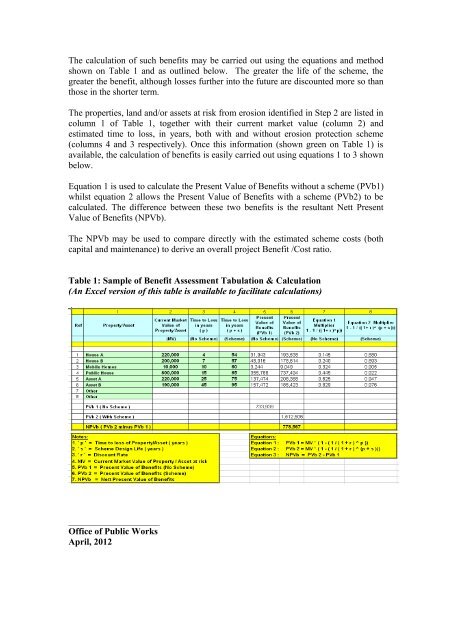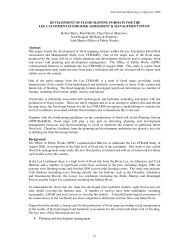OPW Guidelines & Schedules A - B Coastal Erosion Risk ...
OPW Guidelines & Schedules A - B Coastal Erosion Risk ...
OPW Guidelines & Schedules A - B Coastal Erosion Risk ...
You also want an ePaper? Increase the reach of your titles
YUMPU automatically turns print PDFs into web optimized ePapers that Google loves.
The calculation of such benefits may be carried out using the equations and method<br />
shown on Table 1 and as outlined below. The greater the life of the scheme, the<br />
greater the benefit, although losses further into the future are discounted more so than<br />
those in the shorter term.<br />
The properties, land and/or assets at risk from erosion identified in Step 2 are listed in<br />
column 1 of Table 1, together with their current market value (column 2) and<br />
estimated time to loss, in years, both with and without erosion protection scheme<br />
(columns 4 and 3 respectively). Once this information (shown green on Table 1) is<br />
available, the calculation of benefits is easily carried out using equations 1 to 3 shown<br />
below.<br />
Equation 1 is used to calculate the Present Value of Benefits without a scheme (PVb1)<br />
whilst equation 2 allows the Present Value of Benefits with a scheme (PVb2) to be<br />
calculated. The difference between these two benefits is the resultant Nett Present<br />
Value of Benefits (NPVb).<br />
The NPVb may be used to compare directly with the estimated scheme costs (both<br />
capital and maintenance) to derive an overall project Benefit /Cost ratio.<br />
Table 1: Sample of Benefit Assessment Tabulation & Calculation<br />
(An Excel version of this table is available to facilitate calculations)<br />
____________________<br />
Office of Public Works<br />
April, 2012
















